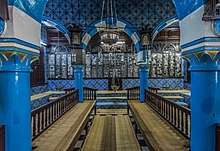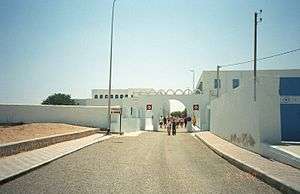El Ghriba synagogue
The ancient El Ghriba Synagogue (Arabic: كنيس الغريبة), also known as the Djerba Synagogue, is located on the Tunisian island of Djerba. It is situated in the Jewish village of Hara Seghira (currently known as er-Riadh), several kilometres southwest of Houmt El Souk, the main town of Djerba.
| El Ghriba Synagogue | |
|---|---|
 Interior of El Ghriba Synagogue | |
| Religion | |
| Affiliation | Orthodox Judaism |
| Rite | Maghrebi (Tochavim) |
| Status | Pilgrimage site |
| Location | |
| Location | Djerba, Tunisia |
| Architecture | |
| Style | Moorish |
The synagogue is the oldest in Tunisia, and besides being the center of the island's Jewish life is also a site of pilgrimage, one of the legends associated with its founding claims that either a stone or a door from Solomon's Temple or the Second Temple is incorporated in the building.
History

Djerba is home to around 1,300 Jews,[1] and El Ghriba is an important feature of Jewish life on the island.[2] According to legend, the construction of the synagogue goes back to the High Priests' escape following the destruction of Solomon's Temple by the Babylonians under Nebuchadnezzar II in the year 586 BCE (or, alternately, the destruction of the Second Temple in 70 CE). The High Priests carried with them a door and a stone of the destroyed Temple. Thus the synagogue links the Jewish diaspora to the "sole sanctuary of Judaism".[3] In modern times, the local Jews are distinguished by their dress, which includes a black band around their pants, which signifies the destruction of the Temple.[4]
Another tradition says the synagogue was built on a spot where a young girl (ghriba, "the isolated one") had lived, that had not been accepted by the others. She died, and her uncorrupted body was found by the Jews of the nearby village, and then buried in a cave which became the site of an annual pilgrimage for Lag BaOmer.[3]
In 1985, during the festivities for Simchat Torah, a local policeman responsible for the synagogue‘s safety opened fire into a crowd of celebrating Jews, killing three people, among them one child,[2] and wounding 15.[5] On April 11, 2002, a truck full of explosives was detonated close to the synagogue, killing 21 people, among whom were 14 German tourists, five Tunisians and two French nationals. Al-Qaeda claimed responsibility for the bombing,[6] which was found to have been masterminded by Khalid Sheikh Mohammed and financed by a Pakistani resident of Spain.[7]
Location

The synagogue is located in the village of Erriadh, southwestward of Houmt Essouk on the Tunisian island of Djerba. The Ghriba is the most famous of the about 20 synagogues that were being used until the 1950s in the three Jewish villages on Djerba.
Buildings
The synagogue was built at the end of the 19th century at the spot where the 6th century building had been.
On the outside, the current synagogue is a modest building, whereas the interior is richly decorated. In contrast to the other synagogues of Djerba, El Ghriba consists of two covered halls. Following several structural extensions the first of the two halls was built through the roofing of a formerly open courtyard in order to increase the capacity for the number of visitors. At the entrance, there are two columns dividing the room into three areas. This hall is connected to the main hall by three vaults. At this side there are two columns, supporting a high skylight of numerous windows. Initially there were twelve windows in the hall, representing the twelve tribes of Israel.
During later renovations further windows were added. The north side also was modified. The Teva (the cupboard for the Torah) is located under the skylight (at the western side of the prayer room). A third column to the east is missing. It probably never got constructed. Local tradition sees that as a reminder of the destruction of the temple of Jerusalem. Furthermore it is said that the building should remain unfinished, because "nothing, except for the divinity, is perfect". The wooden benches for the believers are situated around the Teva. The inner walls are decorated ceramic tiles with blue, white and brown ornaments that were painted in hand work. A recess underneath the holy arc marks the spot where the body of the girl is supposed to have been found: It is known as «the cave of the girl».[8]
The inner courtyard is surrounded by covered loggias standing on columns. Pilgrims can use the adjacent buildings for accommodation. The oldest of them were built at the end of the nineteenth century, whereas the newer ones stem from the early 1950s.
Administration
The synagogue is being supervised by an independent administration committee that was established at the end of the nineteenth century, when Djerba was a French protectorate. The administration committee organizes the annual pilgrimage and distributes the pilgrimage‘s revenues to the village elders.
Pilgrimage

The pilgrimage takes place every year on the 33rd day of the Counting of the Omer, in between Pesach and Shavuot. On the 14th of Iyar, the festivities begin, in remembrance of rabbi Meir Baal HaNess, and last until the Lag BaOmer on the 18th of Iyar, in remembrance of rabbi Simeon bar Yochai (regionally known as rabbi Shimon).
See also
- La Ghriba, a documentary film
- List of synagogues in Tunisia
- Oldest synagogues in the world
- Chaim Madar
References
- "Tunisia's Prime Minister joins guests as Jews celebrate a unique Lag Ba'Omer festival". Jewish Chronicle. May 23, 2019.
- Gilbert, Martin (2010). In Ishmael's House: A History of Jews in Muslim Lands. McClelland & Stewart. p. 345. ISBN 9781551993423.
- Meddeb, Abdelwahab; Stora, Benjamin, eds. (2013). A History of Jewish-Muslim Relations: From the Origins to the Present Day. Princeton University Press. p. 926. ISBN 9781400849130.
- Blady, Ken (2000). Jewish Communities in Exotic Places. Rowman & Littlefield. p. 338. ISBN 9780765761125.
- Chicago Tribune 09 Oct 1985, Page 11 "Shots kill 3 at Tunisia synagogue"
- "Tunisian bomb attack trial opens". BBC.
- Reinares, Fernando (2016). Al-Qaeda's Revenge: The 2004 Madrid Train Bombings. Columbia University Press. p. 88. ISBN 9780231801409.
- DK (2011). DK Eyewitness Travel Guide: Tunisia: Tunisia. New York: DK Publishing. p. 180. ISBN 978-0-7566-8479-2.
External links
| Wikimedia Commons has media related to El Ghriba Synagogue (Djerba). |



